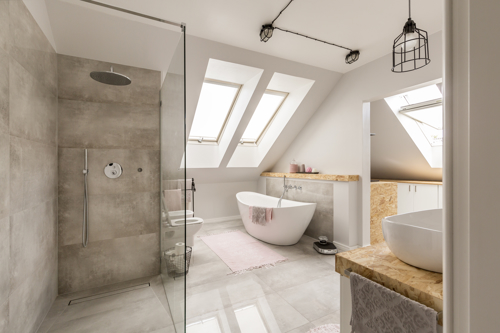
BS 7671:2018 Frequently Asked Questions
The IET’s technical helpline receives a wide range of frequently asked questions. Here are just a few of the common questions received.
Room containing a bath or shower

Socket-outlets
Are 230 V socket outlets permitted in a room containing a bath or shower?
230 V 13 A socket-outlets are allowed but only if they are at least 3 m horizontally from the boundary of zone 1.
Plate switches
Are 230 V lighting switches (plate switches) permitted in a room containing a bath or shower?
A plate switch is allowed outside the zones of a bathroom. A switch must be suitable for the location. The cords of cord-operated switches are allowed in zones 1 and 2 and are recommended for bathrooms and shower rooms.
Luminaires (light fittings)
Are 230 V light fittings permitted above a shower or bath (zone 1) in a room containing a bath or shower?
Yes, 230 V fittings may be installed above a shower or bath, but they must be at least IPX4.
Extractor fans
Are 230 V extractor fans permitted in zones 1 and 2 of a room containing a bath or shower?
Yes, a suitable 230 V extractor fan may be installed in zones 1 and 2, and outside the zones. If an extractor fan is installed in zone 1 or 2 it must be protected against the ingress of moisture to at least IPX4.
An extractor fan supplied from a lighting circuit for a bathroom without a window should have its own means of isolation, as otherwise replacement or maintenance of the fan would have to be carried out in the dark. An isolation switch for a fan with an overrun facility will need to be triple-pole (switch wire, line and neutral), and must be installed outside zones 0, 1 and 2.
Supplementary bonding
Does supplementary bonding need to be installed?
Regulation 701.415.2 (last paragraph) allows supplementary bonding to be omitted where the location containing a bath or shower is in a building with a protective equipotential bonding system in accordance with Regulation 411.3.1.2 and provided all of the following conditions are met:
- All final circuits of the location comply with the requirements for automatic disconnection according to Regulation 411.3.2.
- All final circuits of the location have additional protection by means of an RCD in accordance with Regulation 701.411.3.3.
- All extraneous-conductive-parts of the location are effectively connected to the protective equipotential bonding according to Regulation 411.3.1.2.
Sockets in kitchens
How far away can a socket outlet be from a kitchen sink?
Equipment must be suitable for the environment it is installed in and whilst BS 7671 does not give a distance the IET Electrician’s Guide to the Building Regulations, 5th Edition recommends a minimum of 300 mm from the edge of the sink unit to the socket outlet.
Buried cables
How deep should cables be buried in the ground?
Buried cables, conduits and ducts shall be at sufficient depth to avoid being damaged by any reasonably foreseeable disturbance of the ground. A depth of less than 0.5 m is usually inadvisable. See Regulation 522.8.10 of BS 7671 for more information.
Earthing at lighting points
Is a circuit protective conductor required at a lighting point?
Regulation 411.3.1.1 states: “a circuit protective conductor shall be run to and terminated at each point in wiring and at each accessory except a lampholder having no exposed-conductive-parts and suspended from such a point.” See BS 7671 for more information.
Steel wired armoured cables
Can the armour of a steel wired armoured cable be used as a CPC?
Regulation 543.2 lists types of protective conductor.
543.2.1 A protective conductor may consist of one or more of the following:
(i) A single-core cable
(ii) A conductor in a cable
(iii) An insulated or bare conductor in a common enclosure with insulated live conductors
(iv) A fixed bare or insulated conductor
(v) A metal covering, for example, the sheath, screen or armouring of a cable
(vi) A metal conduit, metallic cable management system or other enclosure or electrically continuous support system for conductors
(vii) An extraneous-conductive-part complying with Regulation 543.2.6.
Note: The designer will still need to determine if the armour is suitable to be used as a CPC.
Meter tails
How long can consumers meter tails be?
Where consumers tails are protected against fault current by the distributors cut-out, the method of installation, maximum length and minimum cross-sectional area (csa) of the tails must comply with the requirements of the distributor.
More information is given in the IET On-Site Guide (BS 7671:2018), 7th Edition.
Conclusion
This article is just a brief overview of some typical queries that we receive on the IET’s technical helpline. For the exact requirements please refer to BS 7671:2018. More information is available in the IET Guidance Notes, the IET Electricians Guide to the Building Regulations and On-site Guide (BS 7671:2018), 7th Edition.
